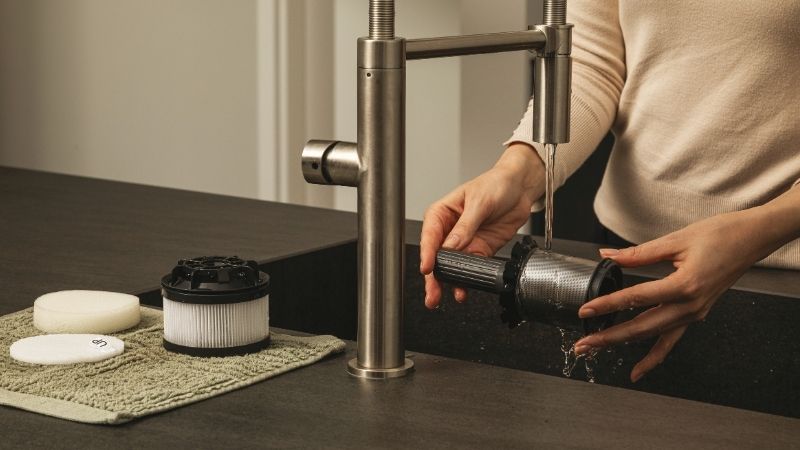Have you ever looked at the different settings on your freezer and wondered what temperature your freezer should be? Does the exact temperature of your freezer really matter? The short answer is yes, the temperature of your freezer is very important for keeping food frozen and safe to eat. In this article, we’ll explore the importance of the ideal freezer temperature, recommended freezer settings, and tips for optimal freezer performance.
Freezer temperature: What should it be?
The ideal freezer temperature is -18° Celsius or lower. This temperature ensures that food is safe to eat and remains frozen, thus keeping it fresher longer. When food is stored at -18°C or lower, the growth of bacteria is prevented, maintaining food quality.
The importance of freezer temperature
Your freezer temperature should never be above -18°C so you don’t have to worry if the food in your freezer is safe to eat. Any temperature higher than -18°C can lead to bacteria growth. Although freezing food at this temperature does not kill bacteria, it does inactivate foodborne microbes like mold and yeast and prevents their growth and spreading.
In addition, keeping your freezer at this temperature helps with long-term storage. When frozen at very cold temperatures, the nutrients and flavors of food are preserved better, leading to higher quality and healthier meals. Proper freezing also preserves the natural moisture content and structure of food, minimizing freezer burn and maintaining its appearance.
Can your freezer be too cold?
Although it is a less common problem, it is also possible for a freezer to be too cold. When a freezer is too cold, it can lead to freezer burn, especially if food is not packaged or stored correctly. It is also possible that some foods become brittle when overly frozen.
For most household freezers, the optimal temperature range is around -18°C to -20°C. This temperature range ensures that food stays frozen while minimizing the risks associated with excessively low temperatures.
It's important to regularly check and adjust the temperature settings on your freezer according to the manufacturer's recommendations and to monitor food quality to ensure it is not adversely affected by temperature extremes.
When should you adjust your freezer temperature?
Newer and more advanced freezer models by trusted manufacturers like Hoover make it possible to check and control the exact temperature and other statistics remotely, right on your phone, making it simple to change your freezer temperature from anywhere. This way, you can relax knowing that the food in your freezer is safe and fresh, even if there are extreme environmental temperature changes (extremely cold or hot weather, for instance).
On more traditional models, you may only have the temperature control inside the freezer. Which setting you choose will depend on what you are freezing as well as the temperature of the environment. You may need to change to a colder setting during summer months, for example, and perhaps a higher temperature setting during the winter when ambient temperatures tend to be a bit lower.
How to avoid freezer burn
It can be devastating to open your favorite ice cream or take out the meat you were planning to cook for dinner and find it covered in ice crystals, the infamous freezer burn. It isn’t harmful to eat frozen food with freezer burn, but it may change the flavor, texture, and nutrient content of the food.
Freezer burn is caused by dry air (low humidity), and food comes into contact with the cold, dry air of the freezer, causing dehydration and oxidation. This can happen when food is not stored properly, or when it is stored for too long in the freezer.
- Store food in airtight containers or bags: Proper storage is key to preventing freezer burn. Freezer-safe bags or plastic containers are best for keeping moisture in food. Try to get as much air out of the bag or container as possible so there is less air in contact with the food. Vacuum sealers are great for freezing food for extended periods of time as they eliminate all of the air surrounding the food.
- Keep your freezer at a consistent temperature: Temperature fluctuations can lead to ice crystal formation as ice melts, becomes water, and refreezes again. Make sure to check and adjust your freezer temperature accordingly to ensure that the temperature is as consistent as possible.
- Don’t overpack your freezer: Striking the right balance of how much food is in your freezer is key. It is best to have the freezer full but not completely packed. It’s important that the chilled air has enough space to circulate, but also that the freezer is not completely empty. If you don’t have a lot of food in your freezer, put some bags of ice in it. Having some items in your freezer helps to maintain the temperature and avoid temperature fluctuations, and you’ll always have ice on hand for smoothies or cocktails.
- No Frost Freezers: The No Frost Technology maintains the temperature and humidity inside the freezer by evenly distributing it throughout. The consistent temperature and humidity of No Frost freezers keep food fresher for longer and also eliminate the need to defrost your freezer.
Conclusion
The temperature of your freezer is very important for keeping your food fresh, healthy, and delicious. The best temperature for a household freezer is between -18°C and -20°C. Maintaining this temperature also helps to reduce the risk of freezer burn. So, be sure to periodically check the temperature of your freezer and consider more high-tech smart appliances that offer detailed statistics and control from anywhere.



